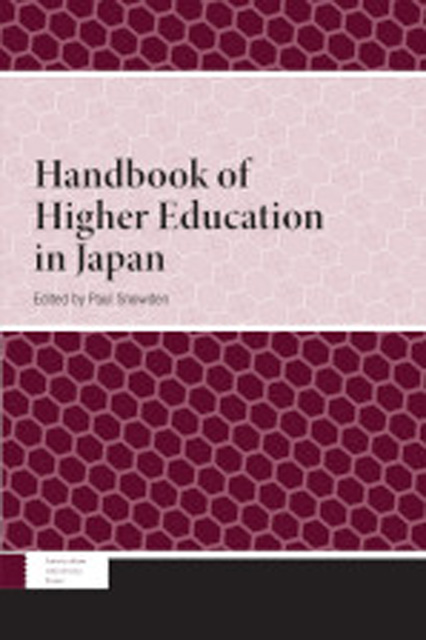Book contents
- Frontmatter
- Table of Contents
- Contributors
- Abbreviations
- Foreword
- Introduction
- Chapter 1 Universities in Modern Japan: A Historical Outline
- Chapter 2 From Showa to Heisei: The Formation of Japan’s Contemporary Higher Education System
- Chapter 3 The Heisei Period: Plus Ça Change?
- Chapter 4 National Universities: Autonomy in Their Governance; Ideology and Practice
- Chapter 5 Public Universities: Prefectural, Local Higher Education
- Chapter 6 Private Universities: Diverse and Adaptable
- Chapter 7 Foreign Universities in Japan: Opportunities Taken and Missed
- Chapter 8 The Financing of Higher Education in Japan
- Chapter 9 Undergraduate Admissions: Shifting Trends
- Chapter 10 The Hensachi: Its Dominant Role in University Rankings
- Chapter 11 Self-Assessment: How Japanese University Students Assess Their Learning Outcomes
- Chapter 12 Policies for Hosting International Students: Issues for the Post-300,000 International Students Plan Era
- Chapter 13 Regional Cooperation in East Asia: Shifting Reality
- Chapter 14 International Students: Inbound Mobility at “Elite” and “Mass” Universities
- Chapter 15 Academic Support and Advising: Historical and Contemporary Issues
- Chapter 16 Women’s Universities in Japan: Life Choices
- Chapter 17 Junior Female Academics: Experiences and Challenges
- Chapter 18 Women of Color Leading in Japanese Higher Education
- Chapter 19 International Faculty: Increasing Mobility
- Chapter 20 Research Universities: Science, Technology, and Innovation Policy
- Chapter 21 Liberal Arts Education: The Japanese Way
- Chapter 22 The English Language in Japan: A Historical Overview 1809–2020
- Chapter 23 Languages Other Than English: Mysterious Eclipse
- Chapter 24 Critical English Curriculum Enactment: A Policy Planning Perspective
- Chapter 25 The Dawn of Reiwa: Waves, Revolutions and an “A.I. Society”
- Appendix 1 Chronology of Japan
- Appendix 2 Japanese National Universities, by Prefecture
- Appendix 3 Japanese Public Universities, by Region
- Glossary
- Index
Chapter 13 - Regional Cooperation in East Asia: Shifting Reality
Published online by Cambridge University Press: 31 May 2023
- Frontmatter
- Table of Contents
- Contributors
- Abbreviations
- Foreword
- Introduction
- Chapter 1 Universities in Modern Japan: A Historical Outline
- Chapter 2 From Showa to Heisei: The Formation of Japan’s Contemporary Higher Education System
- Chapter 3 The Heisei Period: Plus Ça Change?
- Chapter 4 National Universities: Autonomy in Their Governance; Ideology and Practice
- Chapter 5 Public Universities: Prefectural, Local Higher Education
- Chapter 6 Private Universities: Diverse and Adaptable
- Chapter 7 Foreign Universities in Japan: Opportunities Taken and Missed
- Chapter 8 The Financing of Higher Education in Japan
- Chapter 9 Undergraduate Admissions: Shifting Trends
- Chapter 10 The Hensachi: Its Dominant Role in University Rankings
- Chapter 11 Self-Assessment: How Japanese University Students Assess Their Learning Outcomes
- Chapter 12 Policies for Hosting International Students: Issues for the Post-300,000 International Students Plan Era
- Chapter 13 Regional Cooperation in East Asia: Shifting Reality
- Chapter 14 International Students: Inbound Mobility at “Elite” and “Mass” Universities
- Chapter 15 Academic Support and Advising: Historical and Contemporary Issues
- Chapter 16 Women’s Universities in Japan: Life Choices
- Chapter 17 Junior Female Academics: Experiences and Challenges
- Chapter 18 Women of Color Leading in Japanese Higher Education
- Chapter 19 International Faculty: Increasing Mobility
- Chapter 20 Research Universities: Science, Technology, and Innovation Policy
- Chapter 21 Liberal Arts Education: The Japanese Way
- Chapter 22 The English Language in Japan: A Historical Overview 1809–2020
- Chapter 23 Languages Other Than English: Mysterious Eclipse
- Chapter 24 Critical English Curriculum Enactment: A Policy Planning Perspective
- Chapter 25 The Dawn of Reiwa: Waves, Revolutions and an “A.I. Society”
- Appendix 1 Chronology of Japan
- Appendix 2 Japanese National Universities, by Prefecture
- Appendix 3 Japanese Public Universities, by Region
- Glossary
- Index
Summary
While bottom-up informal links, partnerships, and programs among universities in the region have proliferated, so too have government-initiated efforts toward developing regional partnerships in higher education. This chapter will explore these developments at the government and institutional levels, with particular emphasis on top-down policy initiatives for regional student exchange, research collaboration, quality assurance, and foreign credential evaluation. These policies will be considered in light of broader socio-cultural, economic, and political forces continually shaping the region.
Introduction
During much of the 20th century, Japan was recognized as a leader in knowledge production and technological innovation in East Asia, and its well-established higher education system was seen as the best in the region. Throughout this period Japan and its universities adopted an orientation toward East Asia that evolved in line with the modernizing development of neighboring countries. In the postwar period Japan viewed the region as a beneficiary of international education, with subsequent economic development in the region leading to a shift in approach “from aid to trade.” As neighboring economies have continued to develop, in recent decades Japan has been confronted with a new reality: the nation and its universities are no longer “No. 1” in the region, with China surpassing Japan in terms of GDP and a number of countries and societies such as Singapore, mainland China, Hong Kong, and South Korea emerging as strong competitors in the higher education sector. High levels of government funding for R&D by neighboring countries are now juxtaposed by a lack of such support in Japan, resulting from prolonged economic stagnation and challenges posed by the country’s shifting demography. Japan’s position has now been challenged, forcing the nation to reckon with its persistent yet misaligned perception that it is somehow “above and ahead” of its Asian neighbors.
Many in Japan’s government and universities have recognized this new reality, and have sought alternative strategies to augment Japan’s global competitiveness in spite of funding constraints. One such approach has been through internationalization, including various forms of regional cooperation in the higher education sector.
- Type
- Chapter
- Information
- Handbook of Higher Education in Japan , pp. 176 - 187Publisher: Amsterdam University PressPrint publication year: 2021

